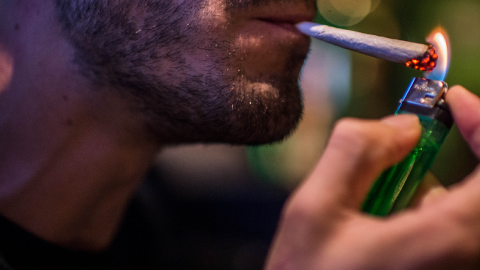A poll reported in the Washington Post (September 23, 2014) offers positive news for those troubled by the movement to legalize marijuana. It also does not auger well for those pushing more states to follow Colorado and Washington, where legalization is already underway.
In a national poll, support for legal marijuana fell seven percentage points in a single year, from 51 percent in 2013 to 44 percent in 2014. The results are well outside the poll’s margin of sampling error, and though only a single result, represent the first sign that the public may be reconsidering what had been climbing enthusiasm.
Of course, public support for issues in the abstract (such as nationalized health care, or ending involvement in Middle Eastern wars) can change when actual events begin to shape perceptions. It is possible that deteriorating public health and public safety conditions in places like Colorado are giving pause.
The public has to be made aware of the actual damage, however, which is no easy task given the widespread presence of media bias on behalf of legal marijuana, both explicitly (the New York Times’ editorial support for legalization) or more implicitly through a steadfast neglect of bad news in reportage (the Washington Post on any given day).
Yet word has gotten out, and credit is due the various groups and individuals (educators, physicians, and family advocates, as well as a small core of policy analysts) who have created a growing source of data and genuine analysis.
But the uphill struggle is not over. For instance, though the Post did cover the poll results, their story contained this striking effort at spin: the results “could mean that Americans generally don't like the news coming out of Colorado and Washington— even if that news has been largely positive.”
Really? The referenced “news”—a Brookings study, the headline of which is, “Colorado’s Rollout of Legal Marijuana is Succeeding”—can only be regarded, charitably, as a weak reed. Sure enough, media coverage followed suit (“Colorado Legalization is Working, says Brookings Institute,” San Francisco Gate, July 31, 2014). Does that mean things are going fine?
Not exactly. What the Brookings report actually argues is that the state has met “the most basic standard of success” because it has “created regulatory and administrative apparatuses that facilitate the legal retail marijuana market.” Is the mere fact that Colorado now has businesses selling marijuana a serious standard of success?
It is revealing is that in order to reference the positive Brookings report, the Post had to climb over a mound of data about the actual impact on the ground in Colorado. A High Intensity Drug Trafficking Area (HIDTA) report in August detailed a parade of damage across the spectrum. And last week’s Quest Workplace Drug Testing national results showed for the first time in a decade an increase in marijuana positives nationally—5 percent overall in a single year—compared with Colorado’s 20 percent increase over that same period. That can’t be a success for businesses, can it?
Showing even more evasion, the Post did decide to report on the impact of legalized marijuana—in Alaska, based on a ruling from 39 years ago—“Alaska Legalized Weed 39 Years Ago. Wait, What?” (September 25, 2014).
The piece attempts to draw implications for the current Colorado “experiment.” In Alaska, we are told, the lesson is, “the sky hasn’t fallen.” Never mind the striking differences between the two states. Alaska “legalized” marijuana in 1975, but not through a voter referendum. Rather, a court ruling held that a provision of the state’s constitution concerning privacy extended to personal possession of marijuana. Voters explicitly overturned this result in 1991, but a successful ACLU suit kept the judges’ ruling largely intact, though a legalization measure on the ballet in 2000 was beaten by 60 percent of the vote.
In reality, not only is the judge’s ruling against federal Controlled Substance law, it is also a continued violation of state law (a felony punishable by up to 5 years in prison and a fine of $50,000) to have more than 25 marijuana plants or more than 4 ounces of pot. And in Alaska it has never been permissible to have commercial growing, sales, or even a commercial building providing pot; homegrown personal amounts only.
To argue that the Alaska scheme is remotely similar to Colorado’s commercial run-away—and that we should evaluate Alaska’s drug use rates or social conditions as though they contained a lesson for Colorado—is to mislead. Colorado is awash in for-profit enterprises enlisting advertising gurus and marketing their products to youth and adults alike. Alaska, thankfully, did not and does not face these conditions—though we are told at the piece’s conclusion that Alaskans “use marijuana twice as much as Americans elsewhere…”
Nonetheless, the Post’s takeaway is that there is clearly no truth to the view that “the slightest departure from full prohibition would inevitably lead to a stoner dystopia, with a nation of drug-addled high school dropouts.”
To make this non-serious point, it is worth noting that the Post also had to “forget” the report in the British journal, Lancet (September 9, 2014), showing that youth who were daily smokers of marijuana had a 60 percent greater likelihood of dropping out of high school. Just as they neglected to even mention the results of the 2013 National Household Survey on Drug Use and Health (September 2014) showing that rates of near-daily use of marijuana have risen some 80 percent since 2007.
Lastly, one more point about Alaska. The total state population (700,000) is roughly a fifth of the Denver metropolitan area (3.3 million). This fact makes national household surveys of drug use in that state less than reliable. In fact, for the use of some drugs, such as methamphetamine and heroin, the numbers are so small in Alaska that extrapolating to the wider population is precarious, and in some cases, difficult to disaggregate from the larger sample of marijuana users.
The Post sees in this data gap an opportunity to speculate. Perhaps, we are told, “Alaskans are substituting marijuana for more habit-forming drugs, such as heroin or methamphetamine.” Well, yes, perhaps; maybe in Alaska marijuana serves as a kind of “reverse gateway,” helping people stay away from the use of other drugs. There are not sufficient data to contradict this conjecture, so why not float it?
Except, the same Lancet study (“Young Adult Sequelae of Adolescent Cannabis Use: An Integrative Analysis”) also provided strong support for the actual “gateway” hypothesis. The study’s authors found that youth who were daily users of marijuana also had an 8 times greater risk to use other drugs, such as heroin and methamphetamine, than youth who did not use. There is further the important 2012 finding in the Proceedings of the National Academy of Sciences that heavy marijuana users in youth lost, over time, fully eight IQ points, enough to diminish many aspirations.
It is impossible to miss the fact that those trying to educate the public about the dangers of the course we are on must overcome a tendentious, even agenda-driven, media “narrative” in support of greater drug access.
The positive news is that the resistance may have begun to check the momentum of the marijuana movement for the 2014 and 2016 electoral cycles, when legalization advocates are planning their big breakout. That there has been some headway in public opinion is no small feat.
There is now an unexpected opportunity to change direction and avert the problems that have been of our own making—or at least the making of the Department of Justice which, following the policy of the then Attorney General, transformed the fundamental guardian against an American drug debacle into a facilitator of legalization nationwide.
It was the explicit guidance of AG Eric Holder that not only would the DOJ decline to defend its Constitutional authority, upheld by the Supreme Court, establishing the pre-eminence of federal law concerning drugs, he further opened the door to Colorado and Washington state by declining to prosecute clear violations of federal law. His departure presents an opening for a return to lawfulness—and protecting many, many young lives now at risk.
Drug policy should at a minimum be a hard question posed for the next AG nominee, appearing before the Senate. And we should hope the reporters covering these confirmation hearings are not blinded by their preference for legal dope. Their readers, it would appear, are rethinking that choice.



















